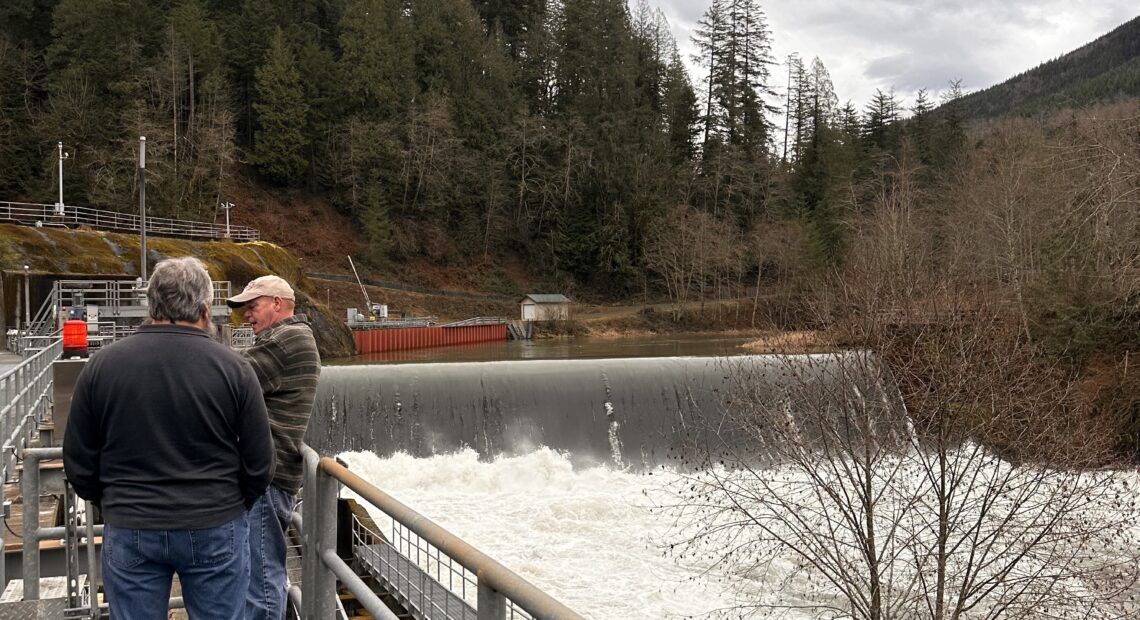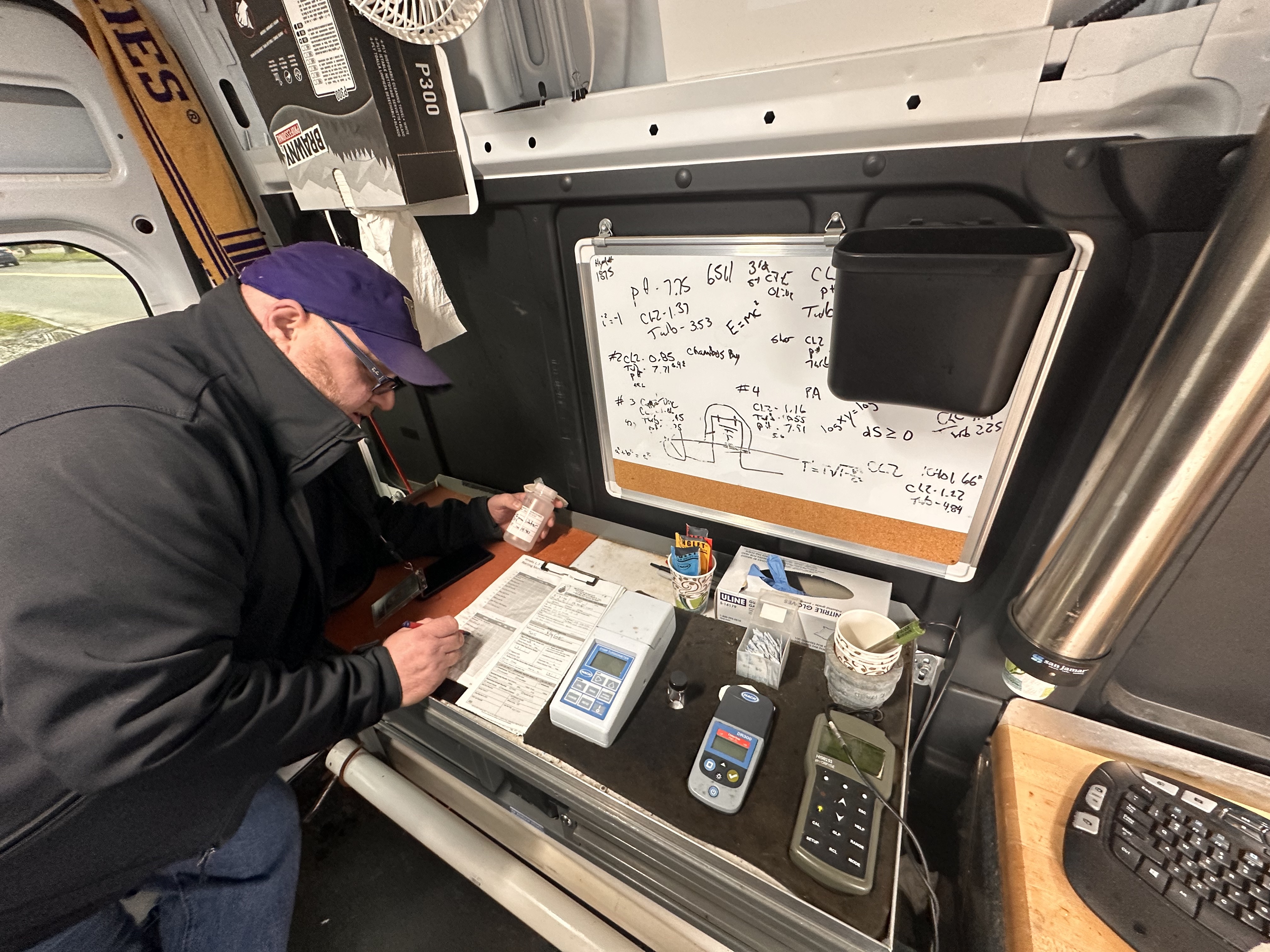
Keeping a close eye on Tacoma’s water
Listen
(Runtime 3:57)
Read
East of Tacoma, across Highway 18, down a packed gravel road, and behind a locked metal gate, Tacoma Water churns over the Green River. This is the source of most of Tacoma’s drinking water.
For years, a lot of that water went to the WestRock paper mill, in the Port of Tacoma, the utility’s biggest customer. At its peak in the 1980s and ‘90s, the mill would draw 35 million gallons of water a day, according to Craig Downs, source and treatment assistant division manager for Tacoma Water.
However, that changed last August when WestRock announced it would close the mill. With that, the nearly 100-year old paper mill, infamous for the Tacoma Aroma, was no more. Some 400 workers lost their jobs. It took a few months but now with the mill officially closed, there is no longer that consistent water draw, and that is a concern for Tacoma Water.
In August, ahead of the closure, Scott Dewhirst, the superintendent for Tacoma Water, said, “We’re trying to maintain water quality, so we want to make sure that the customer sees no downside impact to this at all.”
With changes in water usage and the distance from the source of water to customer’s taps, sometimes water sits in a system for a while before it is used.
“For example, when water flows slow down significantly, such as the difference between summer demand and winter demand, or if a large water user were to shut down their usage, the water turnover is less frequent,” said Derek Pell, who is the regional manager for the Washington State Department of Health’s Northwest Regional Office.
The longer water sits, the more problems can arise. For example, chlorine, which municipalities add to water to make it safe, degrades.
“In drinking water, we rely on chlorine to provide a healthy barrier against biological organisms,” Pell said. “If the water sits in the pipe for a long time, the available chlorine is all used up, and it no longer provides that second barrier of protection against biological contaminants.”
That can lead to regrowth of bacteria and viruses, said Dr. Erica Fuhrmeister, a professor at the University of Washington, specializing in environmental microbiology. Some of those, like fecal coliform and E. coli, can make people sick.
“Probably, the public likes to think that our drinking water system is kind of like a sterile environment, but it’s very biologically active,” Fuhrmeister said.
To deal with the possible issue of water sitting too long, Tacoma Water took the Portland Avenue Reservoir out of service earlier this year. That reservoir, which can hold up to 20 million gallons of water, mainly served the mill. The utility could choose to put it back in service, Downs said. To do that, it would need to be cleaned, which Downs said takes less than a week.

Filtered water runs through huge pipes at Tacoma Water headworks. (Credit: Lauren Gallup / NWPB)
With one reservoir put in a temporary retirement, the utility also is keeping an eye on water quality. One way the utility tests water quality throughout the system is by looking at the chlorine residuals — that’s the amount of chlorine left in the water.
When the drinking water leaves treatment at the Green River, the chlorine is at about 1.3 parts per million, Downs said. Looking at it in town, it’s about 1.1 parts per million. A typical range for chlorine residuals is between .5 and 1 parts per million, Fuhrmeister said.
One part per million is about 10 cups of bleach in an Olympic sized swimming pool.
Tacoma Water has crews test for chlorine residuals in the field four days a week. Water providers must take 180 samples every month, Downs said. Tacoma Water said it exceeds that. Testers such as Kelly Cooper, a water quality specialist, drive to different neighborhoods to get real-time readings of what the chlorine residual is in people’s water.
On Feb. 7, Cooper was on Tacoma’s waterfront testing the water quality, minutes away from the Tacoma neighborhoods that could be most impacted by the mill shutting down.
Hydrologic modeling by Tacoma Water predicted neighborhoods in Tacoma, like North Tacoma and the Eastside would be the most likely to see water sit longer with the mill closed. At times, it can take three weeks for water to get from the Green River to people’s homes in North Tacoma.
On Ruston Way, Cooper went through a specific and lengthy set of steps to get an accurate reading.

Kelly Cooper prepares to test for chlorine residual and coliform in his Tacoma Water van. (Credit: Lauren Gallup / NWPB)
“All my samples kind of have a story to them,” Cooper said. “For instance, your chlorine is going to tell you, ‘Hey, we have a chlorine residual in the system,’ that kind of guarantees that the water is still safe and sterile.”
In that day’s sample, Cooper recorded a reading of .84 parts per million, in the typical and safe range for chlorine in the water. At the same time, Cooper also is testing for the presence of coliform.
If Cooper, or another tester, records a result lower than .2 parts per million, the utility would have to take action.
If there’s not enough chlorine in the water, the utility can flush water in the area, bringing new water in from farther up the system, which should have more chlorine. If the chlorine is low system wide, the utility can add more. Depending on where you live, that change could take a couple of hours or a couple of days to get to your house.
If the sample came back as less than .2 parts per million, Downs said there would be an additional test for HPCs, heterotrophic plate counts, which identifies anything growing in the water. This is recognized as a simple test for water quality.
The utility also would have the original coliform sample, and if that is positive, it also would need to be retested.
The worst case scenario would be if Tacoma Water found bacteria such as fecal coliform or E. coli. If that were to happen, which Downs said never has in the time he’s worked for Tacoma Water, the utility would issue a boil water advisory while it figured out the water quality problem.
Water quality in the region has received some attention in the news recently for a different reason, with Tumwater water sources found to have high levels of PFAS, Per- and polyfluoroalkyl substances, known as forever chemicals, according to reporting by Crosscut. PFAS can pose health risks to people.
According to Crosscut’s reporting, the Environmental Protection Agency is expected to set more stringent regulations for water suppliers around PFAS.
Downs said Tacoma Water tested the Green River for PFAS and did not detect any of the compounds that are covered by Washington State’s 2021 State Action Levels, or those currently proposed for federal regulation by the EPA.
“Produced with assistance from
the Public Media Journalists Association Editor Corps funded
by the Corporation
for Public Broadcasting, a private corporation funded by the American
people.”
















